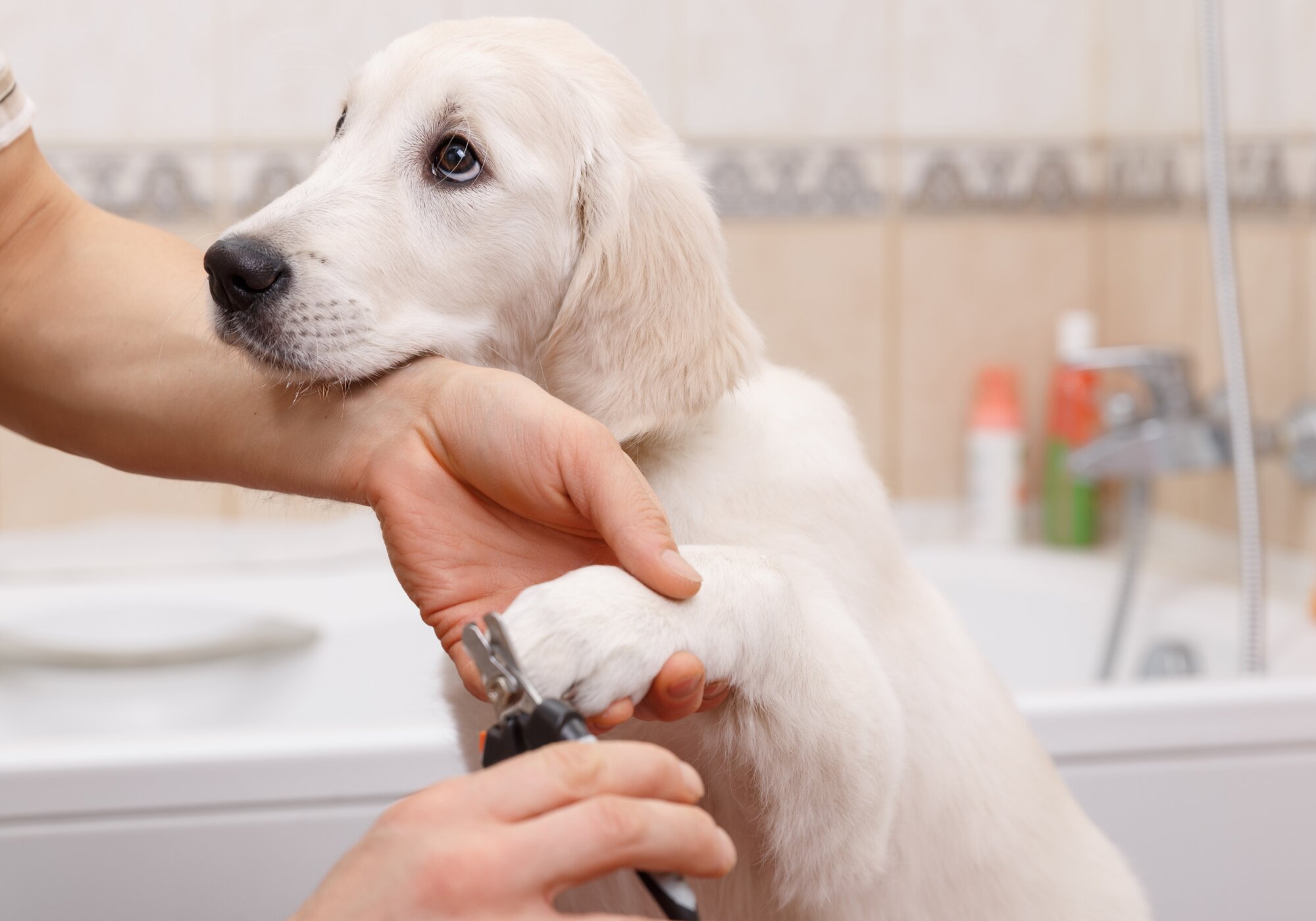Keeping your dog's nails clipped to a healthy length is an important part of pet parenting. If you are a new pet parent or you have not trimmed your dog's nails before, you might be wondering where to begin.
If done correctly, cutting dog nails is a quick and simple procedure. Keep reading to learn how to cut dog nails safely to keep your pet healthy.

How to cut your dog's nails safely

Trimmed nails are a clear sign of your dog's hygiene and health. If your dog's nails are overgrown and constantly hitting the ground, it puts force on their foot and leg structure.
Leaving your dog's overgrown nails untrimmed can eventually lead to other issues like arthritis and pain. Extremely long nails can cause other issues like:
Splayed feet
Splayed feet affect many breeds naturally, but overgrown nails can also cause this condition. When your dog's nails are overgrown, it can cause your dog to slip. This puts pressure on your dog's feet and causes their toes to separate.
Deformed feet
Extra long dog nails can also cause deformed feet. When your dog's long nail hits the ground, the pressure puts force on your dog's foot.
When overgrown nails dig into your dog’s paw, your dog adjusts the way they walk and stand to limit pain. Over time, your dog’s new walking and standing habits can cause deformities in their feet.
Injured tendons
When extra-long nails grow long enough to curl around on themselves into the pad of your dog's paw. The nail can pierce through your dog's skin and damage the tendons in their feet.
In some cases, extra-long nails in dogs can trigger irreversible damage to your dog's paws. So, it's important to maintain a healthy length for their nails with frequent nail trims.

5 dog nail trimming tips

Nail trimming can be a stressful experience for many dogs and squeamish owners. But, there are ways to make the nail trim experience positive for you and your dog.
Save trips to professional groomers every month for regular dog grooming. And follow these tips to trim your dog's nails at home.
1. Help your dog feel comfortable.
The whole process starts by slowly introducing your dog to nail-cutting tools like dog-friendly nail grinders and clippers. Let your pet sniff the tools to become familiar with them.
You can also practice touching and holding your puppy's paws from a young age. This will keep your puppy from becoming sensitive to you handling their paw.
Remember, getting your dog accustomed to the process of nail trimming can take time. Be patient, and offer lots of praise and high-value treats to create positive associations with nail-cutting time.
2. Know how much to cut dog nails.
Once your dog is comfortable with you handling their paws and is familiar with the cutting tools, you can begin. The goal of dog nail trims is to make them as short as possible without making them bleed.
If your pup has white nails, hold onto their paw and press your thumb slightly on their paw pad to expose one nail. Look for the pink part inside of your dog's nail called the quick. Once you find it, make sure you avoid it and do not cut the quick.

If your pup has black nails, extend the nail by pushing your forefinger forward, up, and backward on your dog's paw pad. It can be difficult to see where the quick begins in your dog's black nails.

So, trim a little bit at a time starting at the nail tip. As you cut near the quick, the inside of your dog's dark nails will be chalky white. When you see a black dot in the middle you've reached the end of the quick and should stop cutting.
What is the quick in my dog's nail
The quick is a sensitive area that supplies blood to your dog's nail and runs to the core of the nail. If you cut too close to the quick, the nerves at the core can cause pain and bleeding.
If you take part in regular trimming, the quick will start to shorten and recede from the tip of the nail. A short quick is better for your dog's nails and makes for easy maintenance.
3. Cut your dog's nails at a 45-degree angle.
Rather than cutting your pet's nails straight across, turn the clipper to a 45-degree angle away from your pet. This will ensure that your dog's nails are appropriately cut. This method of cutting also helps pet owners avoid hitting the blood vessel in the nail and trimming too short.
4. Don't forget your dog's dew claws.
Most dogs have an extra set of nails on the inner side of their front legs called dewclaws. Some dog breeds like Saint Bernards and Icelandic sheepdogs also have double dewclaws on their hind legs. If your dog has long hair, you may need to trim some of your dog's fur around their dewclaw to find the nail.
Dewclaws are important to keep trimmed because they can easily get caught on things like carpet and furniture. Overgrown dew claws are also at risk of growing painfully into your dog's leg.
5. Keep your dog on a regular nail-trimming schedule.
Cutting your dog's nails depends on other factors like their lifestyle and age. Some dogs wear down their nails through dog walks and regular exercise. Especially active dogs don’t need their nails trimmed as often as inactive or older dogs.
How often should you trim your dog's nails
- When they touch the ground while your dog stands
- If you can hear their nails clicking or tapping on the ground
Every dog's nails grow at a different pace. If you have a puppy, they will need their nails clipped more often than adult dogs. But, a good rule of thumb is to cut your pet's nails every two to three weeks to keep their quick short and nails healthy.

Tools to cut dog nails
There are a few options for trimming tools that are dog-friendly. Dog owners can choose which tool they are most comfortable using, or whichever tool works best for their pet.
Here are two options for nail trimming tools you can use to cut your pet’s nails.
Dog nail clippers

Guillotine-style clippers are easiest for cutting long nails because they allow for better control and a more precise cut.
Most nail clippers for dogs have a safety guard that helps ensure dog owners don't cut the nail too short. If you have a smaller breed or young puppy with smaller nails, you may find it easier to use nail clippers specifically made for cats or small dogs.
Dog nail grinders

If you’re nervous to clip your dog’s nails, a nail grinder is a safe alternative. You can use a nail grinder with nail clippers to smooth the cut edge of their nails.
The sound and feel of nail grinders can make some dogs anxious. So, introduce nail grinders over time to help acclimate your dog.
What to do if you cut your dog's nails too short

No one wants to be the reason for causing pain in your dog, but accidents happen. Here are three easy steps to comfort your pup if you accidentally trim their overgrown nails too short.
1. Stay calm.
Like humans, your dog's blood pressure rises when they are under stress. This means that if your pup's nail is bleeding, it will begin to bleed faster if they become more anxious.
So, take a breath and stay cool. The bleeding will stop sooner if your dog stays calm and relaxed. If you panic, your pup will mirror your behavior and feel more stressed.
2. Apply pressure.
Apply direct pressure to your pup's bleeding nail with a paper towel or tissue. This will help stop the bleeding quickly. Your dog might be sensitive to touch if their nail is in pain. So, be gentle when applying pressure.
3. Use styptic powder.
If you do accidentally trim your pet's nails too short, have some styptic powder on hand. Styptic powder is a clotting agent that can help stop bleeding in a few seconds so you can tend to your dog's paw if they are in pain.
Styptic powder is safe to use if your pup has a bleeding nail. But, always talk to your vet tech before using styptic powder or any other clotting agent on your dog.
Nail trims don't have to be a stressful process for you or your puppy. Incorporate the act of trimming your dog's long nails into their lifestyle to maintain your pet's hygiene and health. 

